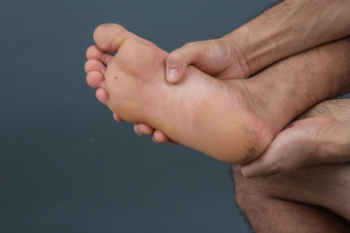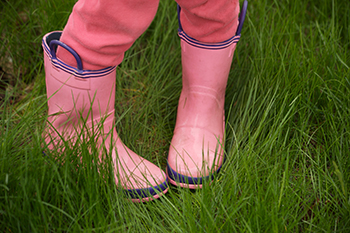November 2024
Finding Relief for Cracked Heels

Cracked heels, also known as fissures, are a common foot condition where the skin on the heels becomes dry, thickened, and eventually splits. These cracks can be painful and, in severe cases, may lead to infection. The primary causes of cracked heels include dry skin, prolonged standing, excessive pressure on the feet, and wearing open-back shoes. To find relief, it is important to keep the feet moisturized with thick creams or ointments that help heal and hydrate the skin. Regular exfoliation with a pumice stone can remove dead skin and prevent the buildup that leads to cracks. Wearing comfortable, supportive shoes with proper cushioning can also reduce pressure on the heels. If you have developed persistent cracked heels, it is suggested that you consult a podiatrist who can offer prescribed medication for effective relief and treatment.
If the skin on your feet starts to crack, you may want to see a podiatrist to find treatment. If you have any concerns, contact Gregory T. Loo, DPM from Elite Podiatry. Our doctor can provide the care you need to keep you pain-free and on your feet.
Cracked Heels
It is important to moisturize your cracked heels in order to prevent pain, bleeding, and infection. The reason cracked heels form is because the skin on the foot is too dry to support the immense pressure placed on them. When the foot expands, the dry skin on the foot begins to split.
Ways to Help Heal Them
- Invest in a good foot cream
- Try Using Petroleum Jelly
- Ease up on Soaps
- Drink Plenty of Water
Ways to Prevent Cracked Heels
- Moisturize After Showering
- Skip a Shower
- Keep Shower Water Lukewarm
- Don’t Scrub Your Feet
If you are unsure how to proceed in treating cracked heels, seek guidance from a podiatrist. Your doctor will help you with any questions or information you may need.
If you have any questions, please feel free to contact one of our offices located in Ahwatukee, and Phoenix, AZ . We offer the newest diagnostic and treatment technologies for all your foot care needs.
Common Foot Problems in Seniors

As people age, they often experience a variety of foot problems that can significantly impact their mobility and quality of life. Plantar fasciitis is a common issue among seniors that is characterized by heel pain due to inflammation of the plantar fascia. Bunions, or painful bony bumps at the base of the big toe, can develop from years of wearing ill-fitting shoes. Corns, which are thickened areas of skin caused by friction, also frequently affect seniors. Osteoarthritis can lead to joint pain and stiffness in the feet, affecting mobility. Additionally, Achilles tendinitis, an inflammation of the Achilles tendon, can cause discomfort at the back of the heel. Addressing these conditions early through wearing proper footwear, doing targeted stretching exercises, and medical intervention can help seniors maintain their independence and enjoy a more active lifestyle.If you are elderly and have foot pain, it is suggested that you consult a podiatrist who can treat various foot conditions, in addition to monitoring your foot health.
Proper foot care is something many older adults forget to consider. If you have any concerns about your feet and ankles, contact Gregory T. Loo, DPM from Elite Podiatry. Our doctor can provide the care you need to keep you pain-free and on your feet.
The Elderly and Their Feet
As we age we start to notice many changes in our body, but the elder population may not notice them right away. Medical conditions may prevent the elderly to take notice of their foot health right away. Poor vision is a lead contributor to not taking action for the elderly.
Common Conditions
- Neuropathy – can reduce feeling in the feet and can hide many life-threatening medical conditions.
- Reduced flexibility – prevents the ability of proper toenail trimming, and foot cleaning. If left untreated, it may lead to further medical issues.
- Foot sores – amongst the older population can be serious before they are discovered. Some of the problematic conditions they may face are:
- Gouging toenails affecting nearby toe
- Shoes that don’t fit properly
- Pressure sores
- Loss of circulation in legs & feet
- Edema & swelling of feet and ankles
Susceptible Infections
Diabetes and poor circulation can cause general loss of sensitivity over the years, turning a simple cut into a serious issue.
If you have any questions please feel free to contact one of our offices located in Ahwatukee, and Phoenix, AZ . We offer the newest diagnostic and treatment technologies for all your foot and ankle needs.
All About Plantar Fasciitis

Plantar fasciitis is caused by an inflammation of the thick tissue that connects the heel to the toes. Known as the plantar fascia, this tissue supports the arch of the foot. When it is overused or overstretched, it can lead to pain and difficulty walking. Risk factors of plantar fasciitis include having flat feet or high arches, running long distances, or wearing shoes with inadequate support. Common symptoms of plantar fasciitis include sharp heel pain, particularly in the morning, and discomfort after long periods of standing or following physical activity. A podiatrist can diagnose this condition by examining the foot and using imaging tests to rule out other issues. Treatment options often involve stretches, wearing special footwear, and orthotics to relieve pressure on the plantar fascia. If conservative methods are ineffective, a podiatrist may explore advanced treatments like injections or custom-made orthotics to reduce discomfort and improve mobility. If you have foot pain that may be caused by plantar fasciitis, it is suggested that you schedule an appointment with a podiatrist for an exam and treatment.
Plantar fasciitis is a common foot condition that is often caused by a strain injury. If you are experiencing heel pain or symptoms of plantar fasciitis, contact Gregory T. Loo, DPM from Elite Podiatry. Our doctor can provide the care you need to keep you pain-free and on your feet.
What Is Plantar Fasciitis?
Plantar fasciitis is one of the most common causes of heel pain. The plantar fascia is a ligament that connects your heel to the front of your foot. When this ligament becomes inflamed, plantar fasciitis is the result. If you have plantar fasciitis you will have a stabbing pain that usually occurs with your first steps in the morning. As the day progresses and you walk around more, this pain will start to disappear, but it will return after long periods of standing or sitting.
What Causes Plantar Fasciitis?
- Excessive running
- Having high arches in your feet
- Other foot issues such as flat feet
- Pregnancy (due to the sudden weight gain)
- Being on your feet very often
There are some risk factors that may make you more likely to develop plantar fasciitis compared to others. The condition most commonly affects adults between the ages of 40 and 60. It also tends to affect people who are obese because the extra pounds result in extra stress being placed on the plantar fascia.
Prevention
- Take good care of your feet – Wear shoes that have good arch support and heel cushioning.
- Maintain a healthy weight
- If you are a runner, alternate running with other sports that won’t cause heel pain
There are a variety of treatment options available for plantar fasciitis along with the pain that accompanies it. Additionally, physical therapy is a very important component in the treatment process. It is important that you meet with your podiatrist to determine which treatment option is best for you.
If you have any questions, please feel free to contact one of our offices located in Ahwatukee, and Phoenix, AZ . We offer the newest diagnostic and treatment technologies for all your foot care needs.
Treatment for Children’s Intoeing

Intoeing, commonly known as pigeon toes, is a condition where a child's feet turn inward instead of pointing straight ahead. This condition often appears in infants and young children and can involve one or both feet. In many cases, intoeing is due to natural variations in bone alignment and often improves as the child grows. For infants, the inward curve may be caused by a condition called metatarsus adductus, where the front part of the foot turns inward. As children get older, intoeing may be related to the twisting of the tibia, or shinbone, or the femur, or thighbone. While intoeing in children often resolves on its own without treatment, a podiatrist can evaluate the condition to determine if stretches, braces, or in rare cases, surgery may be required. Early consultation helps to ensure that your child's gait develops normally and prevents future complications. If your child is intoeing, it is suggested that you schedule an appointment with a podiatrist for an evaluation and treatment options.
The health of a child’s feet is vital to their overall well-being. If you have any questions regarding foot health, contact Gregory T. Loo, DPM of Elite Podiatry. Our doctor can provide the care you need to keep you pain-free and on your feet.
Tips for Keeping Children's Feet Healthy
- Make sure their shoes fit properly
- Look for any signs of in-toeing or out-toeing
- Check to see if they have Clubfoot (condition that affects your child’s foot and ankle, twisting the heel and toes inward) which is one of the most common nonmajor birth defects.
- Lightly cover your baby’s feet (Tight covers may keep your baby from moving their feet freely, and could prevent normal development)
- Allow your toddler to go shoeless (Shoes can be restricting for a young child’s foot)
- Cut toenails straight across to avoid ingrown toenails
- Keep your child’s foot clean and dry
- Cover cuts and scrapes. Wash any scratches with soap and water and cover them with a bandage until they’ve healed.
If you have any questions, please feel free to contact one of our offices located in Ahwatukee, and Phoenix, AZ . We offer the newest diagnostic and treatment technologies for all your foot care needs.









